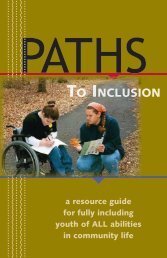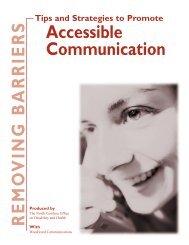Active Citizens 101 - National Service Inclusion Project
Active Citizens 101 - National Service Inclusion Project
Active Citizens 101 - National Service Inclusion Project
You also want an ePaper? Increase the reach of your titles
YUMPU automatically turns print PDFs into web optimized ePapers that Google loves.
Procedures, cont.<br />
4. Distribute Handout 4.1 (b) A History of<br />
Discrimination. Ask participants to read this<br />
section only. Emphasize that the Fourteenth<br />
Amendment is critical to rights in the U.S. It<br />
established the principle that states, as well<br />
as the national government, may not deny<br />
equal protection under the law. No longer<br />
could states pass laws that treated some<br />
groups of people unfairly. Subsequent decisions<br />
of the Supreme Court have extended<br />
the Fourteenth Amendment to assure that<br />
the Bill of Rights protections against abuses<br />
by the national government also protect<br />
people against laws and actions of state<br />
governments. Mention the fact that the historical<br />
time and the philosophy of Justices<br />
on the Supreme Court influence how the<br />
Constitution is interpreted.<br />
Debrief this section by asking: How did the<br />
Thirteenth Amendment affect African Americans<br />
Which amendment said states had to<br />
respect everybody's rights Why was Homer<br />
Plessy against segregation What did the<br />
“separate but equal” rule mean<br />
You may want to supplement this section<br />
with further information—books, pictures,<br />
videos—on race discrimination in U.S. history<br />
(making this a two-day lesson). Some<br />
participants may have little understanding of<br />
the injustice that African Americans have<br />
endured in this country (it is interesting to<br />
note that Homer Plessy's resistance was not<br />
an isolated action. It was coordinated by a<br />
group of Louisiana blacks who hoped that<br />
this type of segregation would be held illegal<br />
under the Fourteenth Amendment).<br />
5. Before reading the next section “The<br />
Supreme Court Thinks Again,” ask participants<br />
how had times changed by 1954<br />
Would there be different Justices Times<br />
had changed: many African Americans had<br />
moved north, President Truman had ordered<br />
the integration of the armed forces,<br />
the nation had over 50 years of segregation<br />
history to analyze, and knowledge of social<br />
sciences such as psychology and sociology<br />
had increased. Note also that many of the<br />
Justices in 1954 had been appointed at a<br />
time when people were winning new rights<br />
and benefits (union rights, social security for<br />
the old, minimum wage, etc.), and by a<br />
President more attuned to civil rights. As<br />
participants may realize, Presidents tend to<br />
appoint Justices who share their political<br />
point of view. Be sure participants know that<br />
Justices are appointed for life.<br />
6. Ask participants to read “The Supreme<br />
Court Thinks Again.” Examine the section<br />
on the doll test with participants. The Brown<br />
decision was the first time the Supreme<br />
Court footnoted social science data in giving<br />
an opinion. The Brown study was one of<br />
several cited to show that racism, of which<br />
segregation was a part, was damaging to<br />
American blacks. While there are criticisms<br />
both of Clark's study and of the Court's inclusion<br />
of such studies, they are part of one<br />
of the most important decisions in the<br />
Court's history. Most folks usually find the<br />
doll test illuminating and memorable. Remind<br />
participants that the test was made<br />
when segregation was common in many<br />
parts of the United States.<br />
You can amplify the reaction of whites both<br />
in the South and in other parts of the country<br />
to the Brown decision and the strength and<br />
creativity of the black civil rights movement.<br />
Mention that the women's movement, Native<br />
American movement, and struggles of<br />
other minority groups owed much to the civil<br />
DRAFT<br />
31






